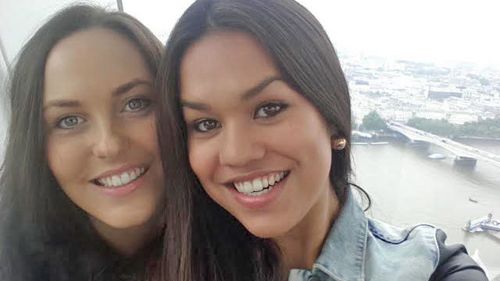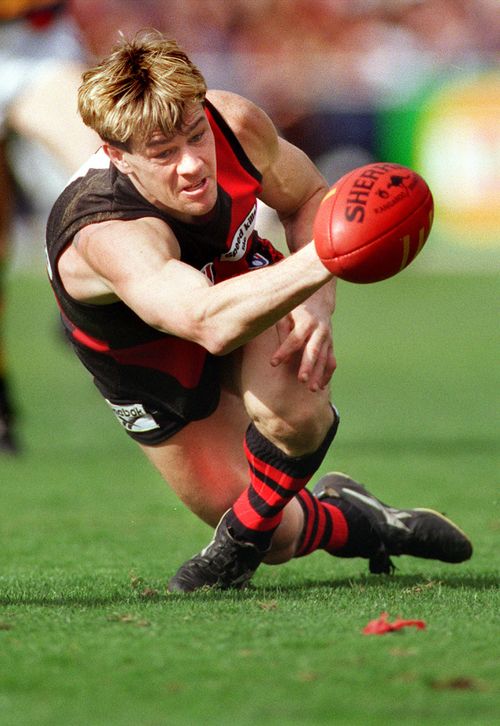Shari Dawson was on a holiday in Europe when she first noticed something strange was happening to her face.
The then 22-year-old had snapped a carefree selfie with a friend.

As time went on, Dawson began to pinpoint other changes in her face.
"The main thing at that stage was my jaw," she said.
"I always used to have quite a normal bite, but I noticed my bottom and top teeth had started touching when I would close my mouth.
"I thought, 'This is really strange, I've never been able to do that before'."
But it wasn't just her jaw that was changing.
"My nose was starting to look different, and my eyes," she said.
Bizarrely, Dawson's feet were growing too.
"My mum and I would always share shoes – I used to be about a seven-and-a-half size," Dawson said.
"Then, over the years, I just kept having to go up a shoe size - to the point where I couldn't buy just a normal pair of shoes."
Dawson had also gained some weight and, initially, she thought this was the reason behind her increased shoe size.

"I went to the doctors and said, 'I've got all this fluid'," Dawson said.
"And I'll just never forget, this lady looked at me and she said, 'I think you're confusing fluid with weight gain'."
The physical changes were so gradual that none of her close family or friends noticed anything amiss, Dawson said.
But Dawson's life was soon derailed by other more serious and debilitating symptoms, including crippling migraines.
"Every other week, I would have a migraine that would knock me out for a few days," she said.
"Sometimes I wouldn't be able to go to work for a whole week because I just could not open my eyes."
A diagnosis at last
By March 2020, the pain of her migraines had gotten so bad that Dawson went to the emergency department of her local hospital - twice.
"The first time I went … they said, 'We're going to send you home. We think this is just a normal migraine,'" Dawson said.
A couple of days later, Dawson was still in agony, so she went back to the hospital.
This time, more tests were done, and it was discovered that Dawson had a tumour in the pituitary gland in her brain.

The tumour, which had likely been growing inside her brain for the last seven years, was bleeding.
Dawson was rushed into emergency brain surgery, and doctors removed most of the tumour.
Doctors explained the tumour had caused Dawson to develop a rare growth disorder condition called acromegaly, which leads to an overproduction of growth hormone in the pituitary gland and abnormal growth in adults.
Acromegaly is thought to affect anywhere from 715 and 3500 Australians, however, experts say it is often misdiagnosed.
Neurosurgeon and pituitary specialist Dr Yi Yuen Wang said many patients faced challenges in getting an acromegaly diagnosis.

"Due to the variety of symptoms, misdiagnosis is a common occurrence for acromegaly patients, which can lead to years of prolonged suffering and health uncertainty," he said.
"It's important that allied health professionals, such as podiatrists and dentists, are aware of acromegaly and its symptoms, should patients present to them."
Early acromegaly symptoms can include migraine, vomiting, enlarged hands and feet, gaps in between the teeth, a pronounced jawline, thickened skin, and a deepening of the voice.
Wang said patients should be proactive about talking to their GPs if they were experiencing symptoms.
"Early diagnosis is essential to prevent life-altering consequences. While surgery is often the primary course of action, medication and radiotherapy may also be considered," he said.
'Am I going mad?'
Former Essendon AFL premiership player turned coach Mark Harvey received an acromegaly diagnosis at the peak of his footy career in 1999.
Like Dawson, it followed a bewildering array of symptoms he couldn't make sense of.
"I began to experience stomach issues, vibrations down the back of my arms, irritable bowel, migraines, and extreme pressure in my head, which were all unusual symptoms for me," Harvey said.
"All of my symptoms at the time seemed unrelated.
"A number of times I thought, 'Am I going mad?'"

Unbeknownst to him, Harvey's acromegaly was causing his pituitary gland to secrete large amounts of growth hormone into his body at a rapid rate.
Surgeons were able to remove Harvey's tumour completely, curing all of his symptoms.
However, Harvey said it was scary to think what might have happened.
"If drug tested by the AFL at the time, I would have unknowingly tested positive due to the large amounts of growth hormone in my bloodstream," he said.
"I'm lucky I was diagnosed and treated before this happened.
"It's been 24 years since my brain surgery, and I thank science and modern medicine for the healthy life I have managed to live since."
Meanwhile, Dawson's acromegaly battle with acromegaly is still continuing.
In June 2021, she had further surgery to remove the rest of the tumour.
However, in January this year, she received news the tumour had returned.
Dawson is now the general manager of the Australian Pituitary Foundation and said she was passionate about sharing her story to help others avoid the pain of misdiagnosis.
"I just think of how different my life could have been if this had been picked up years earlier," Dawson said.
"It's not as though I didn't see people about this pain in those seven years in the lead-up to my diagnosis.
"I went to dentists about the changes in my mouth, I went to physios and chiros about all the aches and pains all across my body.
"I went to a podiatrist about my feet.
"No one at any stage looked at me and said, 'We think you have acromegaly.'"
To further raise awareness about acromegaly, the Australian Pituitary Foundation is hosting a workshop this Saturday, November 25, at St Kilda Life Saving Club in Melbourne.
https://news.google.com/rss/articles/CBMipgFodHRwczovL3d3dy45bmV3cy5jb20uYXUvbmF0aW9uYWwvc2hhcmlzLWJvZHktd2FzLWNoYW5naW5nLWJlZm9yZS1oZXItZXllcy1idXQtaXQtdG9vay1zZXZlbi15ZWFycy1iZWZvcmUtZG9jdG9ycy1maWd1cmVkLW91dC13aHkvYjEyYjMxNDEtOTVmMi00YjNiLWI2MzktNTY3YmY4ZGFiMTZh0gEA?oc=5
2023-11-22 21:46:00Z
CBMipgFodHRwczovL3d3dy45bmV3cy5jb20uYXUvbmF0aW9uYWwvc2hhcmlzLWJvZHktd2FzLWNoYW5naW5nLWJlZm9yZS1oZXItZXllcy1idXQtaXQtdG9vay1zZXZlbi15ZWFycy1iZWZvcmUtZG9jdG9ycy1maWd1cmVkLW91dC13aHkvYjEyYjMxNDEtOTVmMi00YjNiLWI2MzktNTY3YmY4ZGFiMTZh0gEA
Bagikan Berita Ini














0 Response to "Shari's body was changing before her eyes. But it took seven years for doctors to figure out why - 9News"
Post a Comment